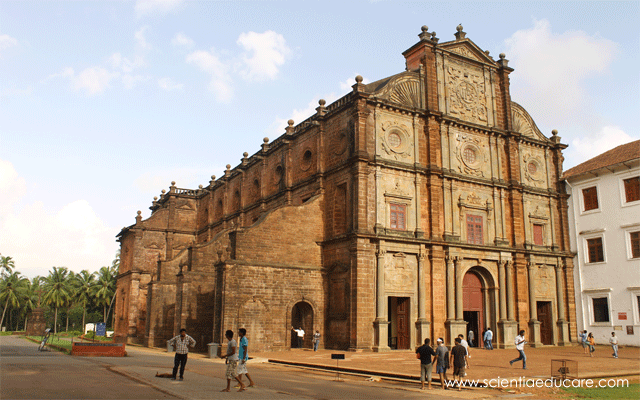Exploring Old Goa: A Timeless Journey into Goa’s Colonial Past
Introduction
Old Goa, also known as Velha Goa, is a historical gem that was once the capital of Portuguese India. Known for its colonial architecture, ancient churches, and cultural significance, this UNESCO World Heritage site is a must-visit for history lovers and tourists seeking a glimpse into Goa’s rich past. With a blend of spirituality, heritage, and scenic beauty, Old Goa offers an immersive experience.
Best places to visit in Old Goa, historical sites in Old Goa, Old Goa churches and museums, Portuguese architecture in Goa, Old Goa travel guide, must-visit places in Old Goa, exploring Old Goa’s heritage, Old Goa sightseeing tour
1. Basilica of Bom Jesus
Specialty & Locality
The Basilica of Bom Jesus is renowned for housing the mortal remains of St. Francis Xavier, making it one of the most significant Christian pilgrimage sites in India. The church’s baroque architecture and intricate carvings make it a masterpiece of the 16th century. Located in the heart of Old Goa, this iconic church attracts thousands of visitors annually.
Best Time to Visit
- October to March (Pleasant weather and festive season)
- December (Feast of St. Francis Xavier)
Nearby Restaurants
- Ritz Classic Panjim – Famous for Goan seafood
- Mum’s Kitchen – Authentic Goan cuisine
- Venite Bar & Restaurant – Portuguese-Goan fusion dishes
Nearby Hotels
- The Fern Kadamba Hotel & Spa
- Old Goa Residency
- Vivanta Goa, Panaji
2. Se Cathedral
Specialty & Locality
One of the largest churches in Asia, the Se Cathedral is dedicated to St. Catherine of Alexandria. It showcases Portuguese-Manueline architecture and houses the Golden Bell, the largest church bell in Goa. The Se Cathedral is located near the Basilica of Bom Jesus, making it convenient for tourists to explore both.
Best Time to Visit
- October to March (Winter months are comfortable for sightseeing)
- Easter and Christmas season for religious significance
Nearby Restaurants
- Kokni Kanteen – Traditional Goan dishes
- Mum’s Kitchen – Portuguese-influenced Goan food
- The Fisherman’s Wharf – Coastal delicacies
Nearby Hotels
- Devaaya Ayurveda & Nature Cure Centre
- The Crown Goa
- Taj Resort & Convention Centre
3. Church of St. Francis of Assisi
Specialty & Locality
Built in 1661, this church boasts a combination of Tuscan, Baroque, and Corinthian architectural styles. The adjoining museum houses artifacts and paintings that depict Goa’s colonial history. It is located within the Old Goa Church Complex.
Best Time to Visit
- November to February (Best weather conditions)
- December (Christmas decorations and festivities)
Nearby Restaurants
- Suzie’s – European and Goan flavors
- Black Sheep Bistro – Innovative Goan cuisine
- The Verandah – Seafood specialties
Nearby Hotels
- Cidade de Goa – Beachside luxury
- Fortune Miramar – Modern comforts
- Grand Hyatt Goa – Lavish stay option
4. Archaeological Museum of Goa
Specialty & Locality
The museum, housed in a former Franciscan monastery, showcases Portuguese weapons, sculptures, paintings, and other relics that highlight Goa’s past. It provides deep insights into the state’s colonial heritage and is situated within the Old Goa Church Complex.
Best Time to Visit
- September to March (Comfortable climate)
- Mornings and evenings for a pleasant visit
Nearby Restaurants
- Mum’s Kitchen – Authentic Goan food
- Ritz Classic – Popular for seafood
- Down The Road – Riverside dining
Nearby Hotels
- Neemrana’s Arco Iris Boutique Homestay
- The Tamarind Hotel
- O Pescador An Indy Resort
5. Church of Our Lady of the Immaculate Conception
Specialty & Locality
Located in Panjim, this iconic church is famous for its white façade, zigzagging stairways, and the second-largest church bell in Goa. It offers a panoramic view of Panjim city and is especially beautiful when illuminated at night.
Best Time to Visit
- November to February (Winter season for a comfortable visit)
- December 8th (Feast of the Immaculate Conception)
Nearby Restaurants
- Fisherman’s Wharf – Seafood specialties
- Ritz Classic – Goan thali and fish curry
- The Black Sheep Bistro – Contemporary Goan cuisine
Nearby Hotels
- Vivanta Goa, Panaji
- The Crown Goa
- La Maison Fontainhas
6. Viceroy’s Arch
Specialty & Locality
A historic arch built in 1599 by Francisco da Gama, the great-grandson of Vasco da Gama, the Viceroy’s Arch was once the main gateway to Old Goa. The structure represents Portuguese grandeur and serves as an important photo stop for tourists.
Best Time to Visit
- October to March (Cooler months for sightseeing)
- Early mornings or late afternoons to avoid crowds
Nearby Restaurants
- Ritz Classic – Authentic Goan flavors
- Mum’s Kitchen – Goan-Portuguese fusion
- Suzie’s – Gourmet dining experience
Nearby Hotels
- The Fern Kadamba Hotel & Spa
- Old Goa Residency
- OYO Stay Goa
7. Chapel of St. Catherine
Specialty & Locality
This small yet historically significant chapel was built by the Portuguese in 1510. It marks the location where Afonso de Albuquerque first set foot in Goa. The chapel’s simplistic design is a contrast to the grandeur of Old Goa’s other churches but holds immense historical importance.
Best Time to Visit
- November to February (Cooler months for sightseeing)
- Early mornings for a peaceful experience
Nearby Restaurants
- Mum’s Kitchen – Traditional Goan dishes
- Ritz Classic – Famous for seafood
- The Verandah – Local specialties
Nearby Hotels
- The Crown Goa
- Old Goa Residency
- Fortune Miramar
Conclusion
Old Goa is a treasure trove of history, culture, and spirituality. From grand churches and colonial relics to fascinating museums, every corner of this historic town tells a story of its glorious past. A visit to Old Goa is not just about exploring monuments but experiencing the legacy of Portuguese rule in India. Whether you are a history buff, a photography enthusiast, or a spiritual seeker, Old Goa promises a rich and fulfilling travel experience.














